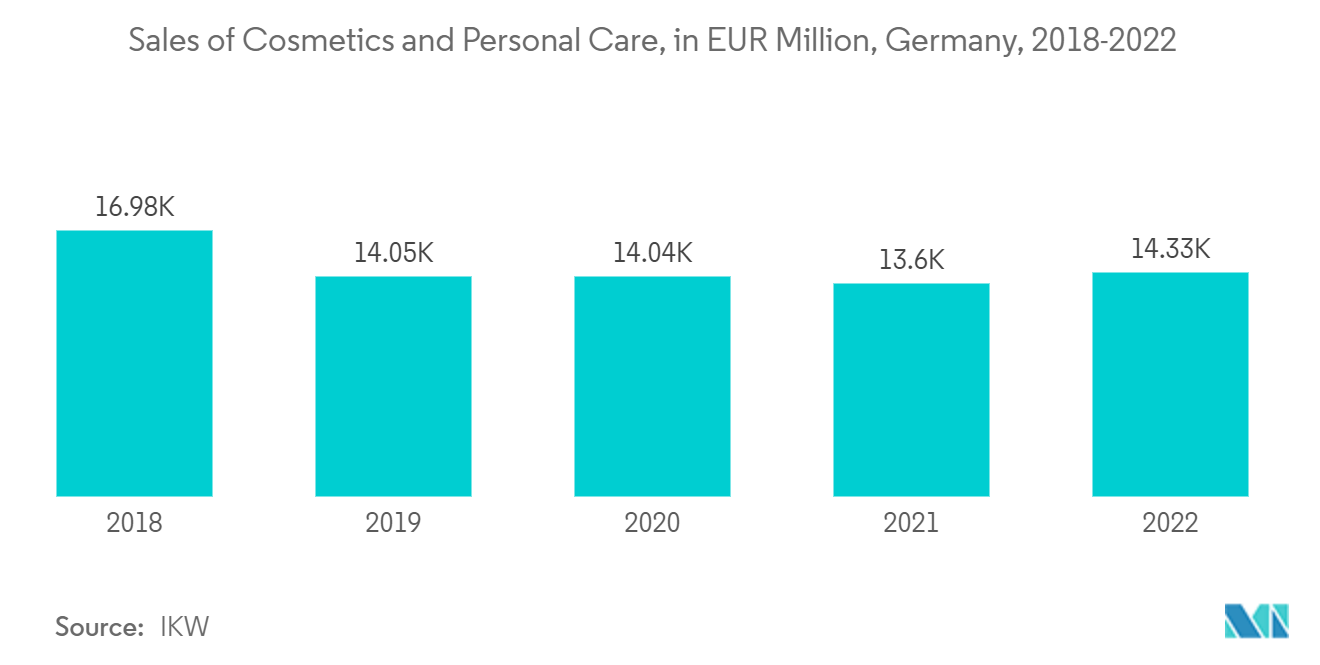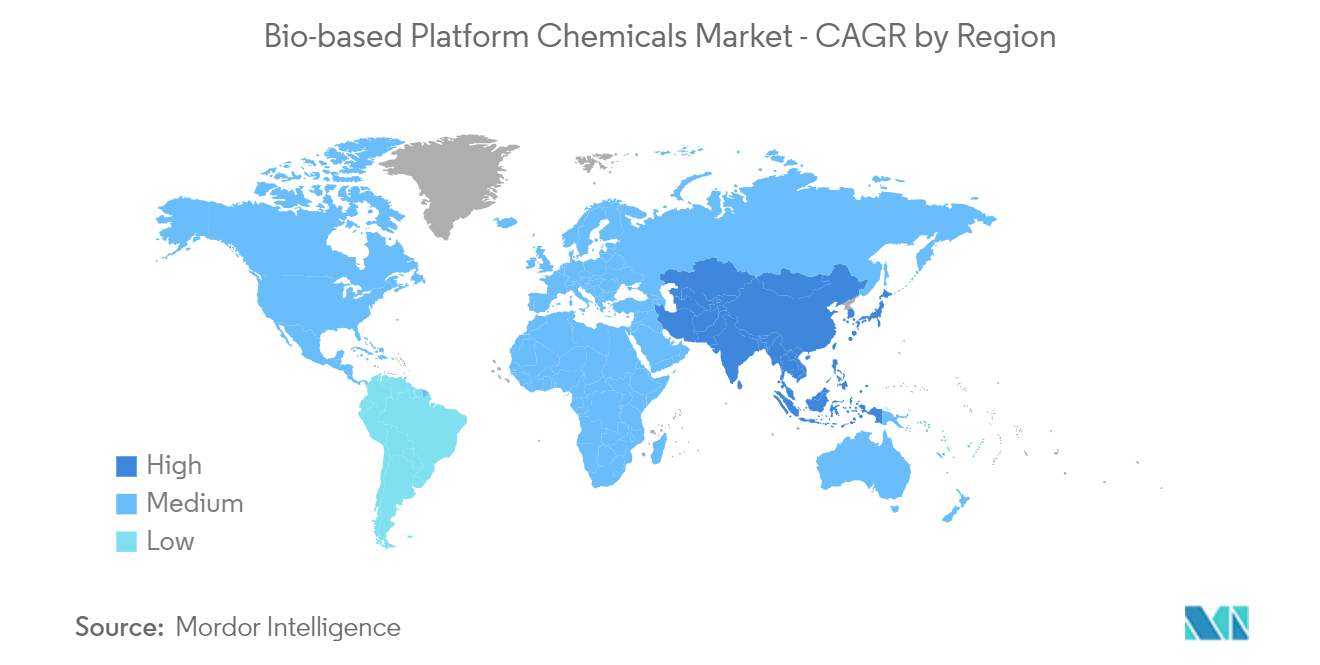Market Trends of Bio-based Platform Chemicals Industry
Bio-Itaconic acid (IA) Segment to Witness Strong Growth
- Itaconic acid (IA) is also known as methylene succinic acid or methylene butanedioic acid. It is an organic compound manufactured through the fermentation process. Furthermore, it is primarily used as an alternative to petrochemical-derived products (including acrylic acid) during the production of various other chemicals.
- One of the major factors hindering the adoption of itaconic acid is the high cost, as compared to its substitutes. Thus, IA is primarily used in areas where less volume of it is required.
- IA can dissolve in many alcohols, including methanol, ethanol, and 2-propanol, as well as biodegradable in nature. Moreover, it is used to produce monoesters, including monomethyl itaconate. It reacts with substituted pyrrolidones, which are used in applications such as shampoos, detergents, pharmaceuticals, etc. Itaconic acid and its derivatives have major applications in the chemical, textile, and pharmaceutical industries.
- According to Cosmetics Europe, the personal care association, Europe's 500 million consumers use cosmetic and personal care products every day to protect their health, enhance their well-being and boost their self-esteem. Ranging from antiperspirants, fragrances, make-up, and shampoos, to soaps, sunscreens and toothpaste, and cosmetics.
- According to Cosmetics Europe, Europe is amongst the major markets for cosmetics and personal products, and retail sales of these products were valued at around Euro 88 billion (USD 85.64 billion) in 2022. The major market in Europe for cosmetics and personal care are Germany (USD 13.92 billion), France (USD 12.55 billion), and Italy (USD 11.19 billion) in 2022.
- Bio-based itaconic acid is used instead of acrylic acid, primarily in the production of superabsorbent polymers. The depletion of fossil fuels and the need for sustainable development is likely to augment the demand for bio-based itaconic acid for the production of superabsorbent polymers during the forecast period.
- The increasing application of superabsorbent polymers in several end-user industries is one of the factors driving the demand for bio-based itaconic acid. Superabsorbent polymers (SAPs) are materials that possess the ability to absorb and retain large volumes of liquid or aqueous solutions. This makes them ideal for use in water-absorbing applications, such as baby nappies, adult incontinence pads, absorbent medical dressings, and controlled-release drugs.
- Organizations, such as the World Health Organization, World Bank Group, and UNICEF, are raising awareness about the importance of hygiene, especially menstrual hygiene management (MHM) for women and adolescent girls.
- In India, the World Bank Group initiated a flagship sanitation operation under the Swachh Bharath Mission. With this operation, awareness is increasing among the community, including boys and men, to break the taboo around menstruation. Such initiatives by government bodies are increasing the demand for bio-itaconic acid, in turn fueling the growth of the bio-based platform chemicals market.
- Thus, the surge in demand from cosmetics and personal care products is further expected to boost the demand for bio-based platform chemicals market.

North America Region to Dominate the Market
- North America region dominated the global market share and is likely to continue holding the major share in the bio-based platform chemicals market during the forecast period, owing to government regulations promoting the use of bio-based products and continuous research and innovations in the field of technological modification.
- Moreover, stringent regulations related to petroleum-based platform chemicals and depletion of fossil fuel reserves further provide a growth opportunity for the bio-based platform chemicals market in the region.
- In addition, end-user industries such as food and beverage, cosmetics, pharmaceuticals, and fertilizer in the region are strictly regulated in order to avoid negative effects on the health of citizens. In this regard, these industries are more likely to shift to bio-based raw materials when compared to petroleum-based raw materials.
- The healthcare sector in the United States is by far one of the most advanced sectors in the country. According to the Centers for Medicare & Medicaid Services, by 2028, it is anticipated that national health spending will have increased by an average of 5.4%, totaling USD 6.2 trillion. Moreover, Health spending per person in the United States was roughly double that of Germany and four times that of South Korea.
- According to US Census Bureau, the health and personal care store sales in the United States in 2022 accounted for nearly USD 399.37 billion, which will be USD 387.0 billion in 2021.
- According to the European Federation of Pharmaceutical Industries and Association, the world pharmaceutical market was valued at USD 1,287,736 million in 2022, in which North America accounted for a significant share of 52.3%.
- Thus, the significant growth in the pharmaceutical and personal care sector in this region is boosting the demand for biobased platform chemicals.
- Further, research and development of bio-based platform chemicals and exploration of their beneficial applications in such industries can lead to the mandate of the use of such bio-based platform chemicals in the region.
- Hence, all such factors are likely to drive the demand for bio-based platform chemicals in the region during the forecast period.


